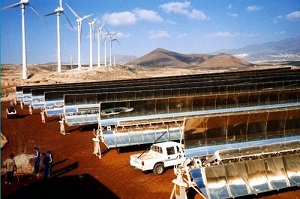Reviewing last week's solar energy news
 The solar world continued to march forward last week. As solar companies began reporting their first quarter 2011 results, the demand for solar continued to keep supplies relatively short, and Italy’s government moved forward with incentives that will keep demand in that country high.
The solar world continued to march forward last week. As solar companies began reporting their first quarter 2011 results, the demand for solar continued to keep supplies relatively short, and Italy’s government moved forward with incentives that will keep demand in that country high.
Given the high level of demand for solar and the incentives that make it easier, it’s no wonder that already incentives are starting to dry up for 2011. Already, the incentives programs offered by utilities in Los Angeles and Detroit have been fully subscribed, or, in Los Angeles’ case, significantly oversubscribed.
Solar investors reacted last week to Total’s (CAC: TOTF.PA) proposed purchase of SunPower (Nasdaq: SPWRA, SPWRB) with a sell-off of solar stock after an initial surge that raised their value by more than 4 percent.
The news was also less than rosy when First Solar Inc. (NASDAQ: FSLR) said its first quarter 2011 earnings were lower than the previous years’ quarter. The company reported earnings of $116 million for this year’s first quarter compared to $172.3 million for the previous year’s first quarter. It cited uncertainty in the European market and lower average selling prices.
First Solar and other solar companies’ feared that Italy’s incentives, including its feed-in tariff, would be eliminated. It’s currently the world’s second largest solar market, behind Germany. The country debated the fate of its incentives much longer than anticipated, but its environment and industry ministries came together with a plan that would reduce the incentive, but still allow and encourage more solar development there.
In other positive news for the solar industry, SunRun secured $200 million in financing from U.S. Bancorp. The financing will allow SunRun, which offers homeowners a solar power service similar to a lease, to expand its offerings in its existing or future markets.
Developments like that continue to show that the solar industry is maturing. As does a new cleantech venture capital report from Ernst & Young. The report found that investments in cleantech grew 54 percent on a quarter-over-quarter basis and that just shy of a third of those investments were specifically focused on solar power, making solar a rising investor darling.
However, the industry still needs some governmental support, particularly at the state level. The National Renewable Energy Laboratory’s “State of the States 2010” report found that renewable portfolio standards (RPS) and interconnection policies affect the amount of solar and renewable generation in states.
For their part, states are moving forward with such legislation. Last week, Colorado’s legislature passed the Fair Permit Act, which standardizes and streamlines the permitting process for solar installations in the state. The act would greatly simplify the solar permitting process throughout the state of Colorado. It’s ground-breaking legislation that the solar industry and investors have been clamoring for as one means to help reduce the so-called “soft-costs” associated with solar installations.
Pending legislation to increase solar in North Carolina got a boost last week with the North Carolina Sustainable Energy Association’s (NCSEA’s) release of the North Carolina Sustainable & Renewable Energy Survey. The survey showed that 91 percent of all North Carolinians want more solar power in their state.
The Department of Energy held a Tribal Summit with Native Americans last week to discuss renewable energy on tribal lands. Energy Secretary Steven Chu spoke at the conference, saying the U.S. was committed to renewables on native lands and was aware of issues that could slow or halt development, including transmission issues.
Image courtesy of NREL.



